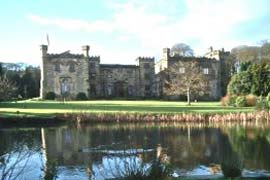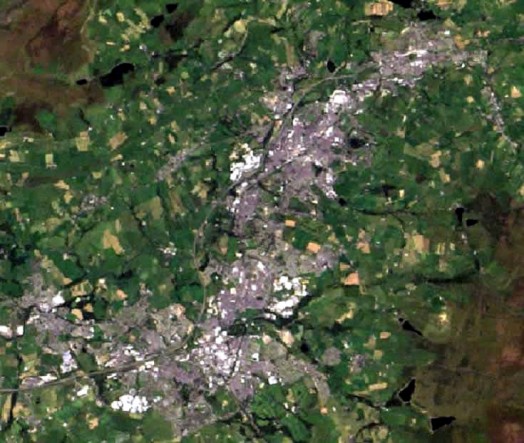BURNLEY YESTERDAY
CLICK HERE to read about Burnley today.
Burnley derives its name from the river Brun and the Old English word 'lëah' meaning 'The field beside the River Brun'. The first recorded use of the name was in 1124 when it was described as 'Brunlaia' but by 1258 this had become 'Burneley', very similar to its present day pronunciation. Although the market charter dates back to 1293 there is a record relating to Pontefact Priory in 1122 which mentions the settlement of 'Brunley'. The original town was centered around St Peters Church where a church has existed since the 13th century.
Towneley Hall was the home of the Towneley family from the 14th century until 1902. Charles (1737 - 1805) was one of the 18th century’s best known collectors of antique sculpture and gems and his famous portrait by lohan Zoffany takes pride of place in the art gallery, today's visitors to Towneley Hall can still catch a glimpse of how the family lived. Original period rooms include the Elizabethan long gallery and the Regency rooms, see how they compare with life below stairs in the Victorian kitchen and the servants’ dining room.

It is rumoured that the Hall is haunted by a spirit whose visits were limited to once every seven years, when its thirst for vengeance had to be satisfied by the untimely death of one of the Hall residents.
Legend says that Sir John Towneley (1473 -1541) was said to have offended and injured the poor of the district by enclosing some of the areas Common Lands, making it part of his estate. As a punishment, his soul is said to wander about the Hall, crying out: "Be warned ! Lay out ! Be warned! Lay out! Around Hore-Law and Hollin-Hey Clough, To her children give back the widows cot.
For you and yours there’s still enough". This Boggart is the famed Towneley.
The lands were granted by the Honor of Clitheroe, Roger De Lacy, to Geoffrey, his son-in-law, in the year 1200. Over the centuries many alterations have been made to the Hall, so many that the Hall is now totally different to its original layout. The first major alterations in 1628 involved the use of 541/2 tons of lead for the roof, purchased from the local Thieveley lead mine, and the last were in the early 20th Century, when the Art Galleries were added. At one time the main entrance was moved. To the left of the ‘new’ main door can be seen a smaller, filled in doorway, the original entrance.
The oldest intact part of the building is ‘the South-East Wing, containing the Long Gallery and the Guest Rooms for family guests. The Red Drawing Room was designed by Jeffrey Wyatt in 1817, the same Wyatt responsible for much of the redesign of Windsor Castle for King George IV. At the same time, a passageway was constructed to allow servants to carry food, linen, bedpans, etc. around the house without intruding on the Family. When using this passageway you will come across the ‘Dungeons’, in reality simply cellars where the family ale was kept. To this day you can still see the marks left by the barrels of ale ale brewed in the estate Brew House now the Museum of Local Crafts and Industries.
Towneley Hall and Park were purchased by the Burnley Corporation on June 24th, 1899, for the princely sum of £17,500. The purchase included the Hall and 61 acres of adjoining land. It was formally opened as a Public Park on June 28th, 1902. The Hall was ‘refurbished’ and fitted out as an Art Gallery and Museum. The first exhibition began on May 20th, 1903 and was opened by the Earl of Rosebery K.G., K.T.
lf you’re looking for the museum’s collections, you’ll find them all around you - glass. ceramics and 17th century Lancashire oak furniture. Pictures by many favourite Victorian artists can be seen in the recently refurbished art galleries. including works by Sir Edward Coley Burnelones. John William Waterhouse and Sir Edwin Landseer.
The Whalley Abbey vestments are another highlight. Embroidered in silk and silver thread on cloth of gold they were brought to Towneley Hall for safe keeping in the 16th century and are now extremely rare. With our regular programme of temporary exhibitions, there is always something new to see and before you leave, don’t forget to say hello to ‘Bill’, our resident Himalayan bear.
Step back in time with a visit to the Museum of Local Crafts and Industries Located in the old brew house alongside the main Hall it tells the story of Burnley people at home and at work using exhibits, photographs and stories told by local residents.
At the Natural History Centre you can learn all above the animal and plant life of the local area through interactive displays and specimens from the museums collections. Come face to face with marine and freshwater fish in the Aquarium - a great favourite with children! In Towneley Park you can follow woodland trails, visit the wildlife garden. play golf, bowls, pitch and putt or even just walk the dog. Why not bring a picnic and enjoy the view!
In 1926 a War Memorial was erected in the park and was unveiled on December 12th by the Earl of Derby. in July 1931 Playing Fields, a Golf Course, Bowling Greens, and Tennis Courts were added, taking the acreage up to 183 acres.
CLICK HERE to read about Burnley today.
Go HERE if you're interested in old photo's of Burnley.

Aerial view of Burnley, Nelson and Colne.
